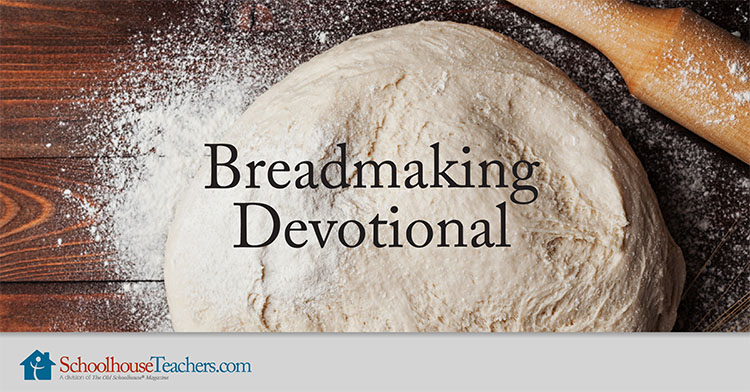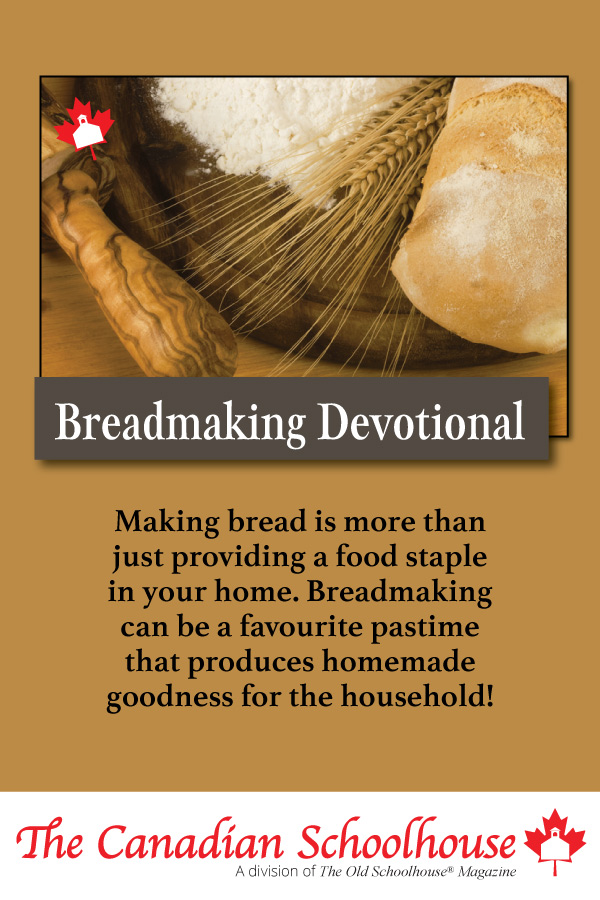
Making bread is more than just providing a food staple in your home. Speaking to some people who make bread regularly, you may hear about the relaxing process, the comforting smells in various steps (not just the delightful aroma of that fresh-baked loaf out of the oven), or the peaceful feeling of kneading and handling the dough. Breadmaking can be a favourite pastime that produces homemade goodness for the household!
Whether you think of making bread as enjoyable kitchen time or just appeal to the benefits of knowing how to whip up a fresh loaf or biscuits, this sample from the breadmaking course on SchoolhouseTeachers.com will give you a delicious biscuit recipe and other learning opportunities for your whole family to take part in.
If you're not a SchoolhouseTeachers.com member, you can use this sample lesson as a stand-alone teaching that covers basics about biscuits, a recipe to prepare, a few general baking tips and some history and Bible-teaching tidbits. The complete lesson is seen below, but you can get a printable PDF through the Course Sample link on the Breadmaking Devotional about page.
If you are a SchoolhouseTeachers.com member, then you've got access to the whole course, but we hope this short sampling has introduced you to one of our great courses that you may not have found yet.

Unit 5: Biscuits and Adapting Recipes
Objectives:
- To make a basic biscuit dough and bake biscuits
- To use the dough to bake a different food than a basic biscuit
- Biblical insights regarding bread
This dough may be refrigerated for a week or ten days. Use it to make one biscuit or a whole batch. Use the dough as the basis for a variety of goodies:
Video to watch on making basic biscuit dough: https://www.youtube.com/watch?v=qQhQp2O_M2Y
Preparation checklist:
- Watched video
- Read recipe
- Have all ingredients
- Have all utensils/tools needed
- Washed work surface
- Washed hands
- Camera/phone ready to take photos
Mona’s Civil War Biscuits
This great basic biscuit dough has a little history. It was used as early as the Civil War in West Virginia. People teased that if the Southern generals had used it they would have won the war. It was adapted later to use self-rising flour (leaven is already in with the flour).
Make it and store it for several days. If you keep it a week or more, it will taste and smell like a sourdough biscuit because the yeast has fermented longer in the refrigerator.
Ingredients
Equipment
Method
- Sprinkle yeast into 1/4 cup warm water and set the timer for ten minutes to let the yeast dissolve.
- Sift flour, soda, and sugar together in a large bowl.
- Blend in shortening.
- When the timer is done, add yeast mixture and buttermilk and mix well. Make sure the flour at the bottom of the bowl is mixed in.
- Cover bowl and store in the refrigerator to use as needed.
- When ready to bake, heat the oven to 400°F.
- Pull off enough dough for the number of biscuits needed. Cut biscuits out on a lightly floured surface (don’t twist the cutter). Put a little flour on your hands. Place biscuits on a greased pan and bake until lightly browned, about 10 minutes (no need to wait for dough to rise).Note: Handle dough as little as possible. Your hands warm the dough, and that can impact rising in the oven.
Observations
To improve in cooking or to be consistent if things go well, take time to evaluate what you made. This includes the appearance, taste, doneness, and notes on any changes for making it again. Changes might include less or more cooking time (ovens and altitude vary and may mean you need to change the oven temperature or length of baking time).
- Doneness (cooked through, not burnt, etc.)
- Taste and appearance (outside color, inside texture)
- Changes to make next time
Once you have made and refrigerated some of the dough, consider ways to use the dough for something different.
Adapting the dough for other treats
You can vary the biscuits by adding other ingredients before rolling the dough out or filling dough that you roll out.
- Add herbs, cheese, or other ingredients to make specialty biscuits.
- Use the dough to make turnovers, cinnamon rolls, or other desserts.
- Use the dough with meat or chicken to make a main dish.
Watch these videos for ideas on using the dough for a variety of purposes.
- Make apple/fruit turnovers: https://www.youtube.com/watch?v=5WbkabVpBbw
- Make maple bacon biscuits: https://www.youtube.com/watch?v=yq4QxtdVxvs
- Make pot pies: https://www.youtube.com/watch?v=oeb3MfezbAs&t=1s
The sample PDF includes a section here to plan out what you’ll make next with the biscuit dough.

Biblical Insights
The manna was like coriander seeds. It looked like sap from a tree. The people went around gathering it. Then they ground it up in a small mill they held in their hands. Or they crushed it in a stone bowl. They cooked it in a pot. Or they made loaves out of it. It tasted like something made with olive oil. (Numbers 11:7–8, NIrV)
How many different ways did the Israelites cook the manna?
Look up the definition of versatile.
How was manna versatile, and how is biscuit dough versatile?
Look at coriander seeds in the spice section of a grocery store. You might choose to buy some and add it to biscuit dough. Describe coriander seed.
Play a Manna Game
Have an adult toss out a roll of pennies and see how long it takes to gather them. If playing with others, divide the number of coins by the number of people and state how many each one can collect. (The Israelites could only collect what they needed for one day except the day before the Sabbath.)
Chat about the Israelites and collecting manna.
Read John 6:30-41.
What did Jesus say about manna?
How is Jesus better than manna God sent from heaven?
How is Jesus, the Bread of Life whom God sent from heaven, versatile? (List some things Jesus did and can still do.)
More About This Course
Each of the twelve lessons included in this course includes instructions, lesson objectives, and Biblical insights. Lessons 1–3 help students learn the basics before baking bread, such as safety, the tools needed, baking terms, and how to follow recipes. Lessons 4–10 focus on baking various types of bread, including breads from around the world. Lesson 11 focuses on serving, storing bread, and making bread centerpieces. Lesson 12 focuses on making money with bread and shares the stories of some successful bread-based businesses.
Get your PDF copy of this sample lesson from the Breadmaking Devotional course.
If you’d like to see all that SchoolhouseTeachers.com has to offer your family (one membership price for every member of your family – including access to lots of parent resources!), then go to the membership page for all the pricing options.















